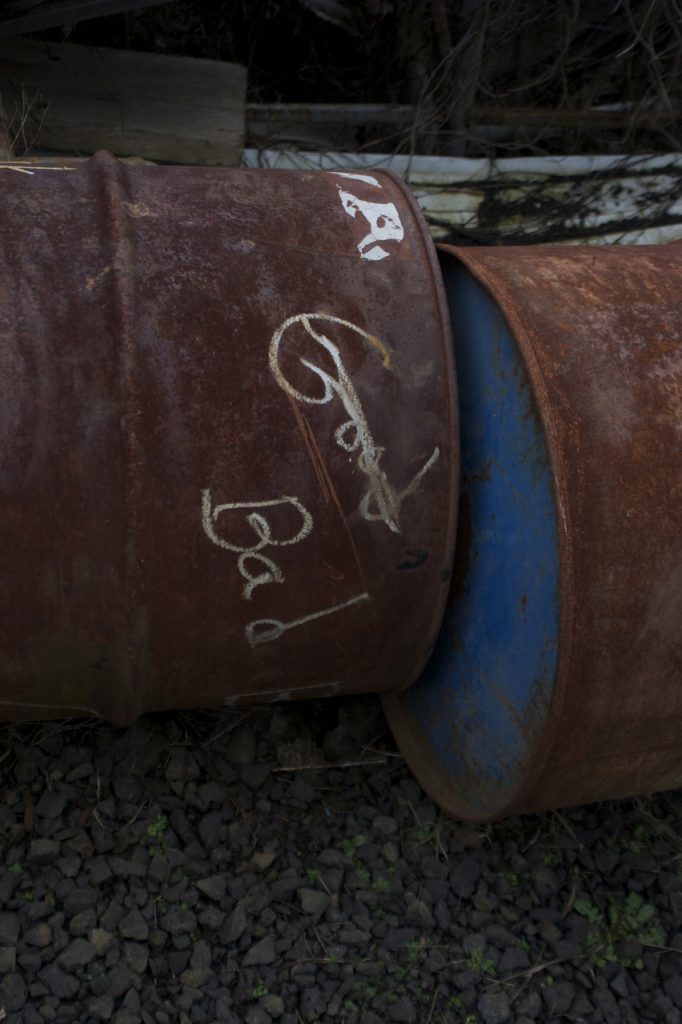a literary journal published by the Black Earth Institute dedicated to re-forging the links between art and spirit, earth and society
Nch’i-Wana
She lies dreaming of the time she was pure,
sleeping in the roar at Wyam and Shonitkwu,
salmon tails brushing rocks as they leap.
Thwock of cedar mauls near Skamokawa splitting planks for burial canoes,
in the trees each with precious cargo, points toward the sea, takes the ancestors to the stars.
At her mouth, soft feet, the brush of cedar nets, around those ankles, cotton skirts slosh water, the heavy touch of salmon on sand.
Linen nets, horses’ hooves pull the full nets,
gillnetters putter, leave an iridescent glow in the slack water of Blind Slough,
ferries make a slow beat from the Kathlamet’s camp to the marshy island,
where chicken coops float up and down with the tide.
Restless, her bed picked clean, stumps gone, the snag puller’s cables coiled
summer dredges vacuum memories of sturgeon, ghost runs of salmon sweep past,
She hears oceangoing ships’ horns along her rip-rapped banks, calls down the cataclysm that will sweep her free.
Note: Nch’i-Wana: The mid-Columbia Native Americans called the Columbia River Nch’i-Wana.
We say the Columbia River drains an area the size of France,
let the sibilance help us get our arms around the 1,243-mile long snake
we have channeled.
With his sixty years along her bank, my husband speaks the language of her insult Micah, Revelstoke, Grand Coulee, Bonneville, and McNary, for an Oregon senator, John Day, for a woodsman lost from the Astor party in the winter of 1811.
I wonder if the engineers who stopped salmon from returning to the upper Nch’i-Wana at the Chief Joseph Dam rest well, and whether naming that life-stealing dam for the great chief made them sick.

The Lower Chinook, who included the Wahkiakum, the Kathlamet and the Clatop, said the island was so wet only deer could live here.
In 1910, hungry, hemmed in by the North Sea and the Norwegian Sea, squeezed by ice and snow to the water’s edge, my father-in-law found this island in the Columbia, the promised land. The men built dikes that made the island into a bowl.
Formed of alluvial silt, those finest of particles dry into concrete in the summer. In the wet months, the water table is at ground level. Pastures fill with bulrushes, sedge and reeds: wet-land plants. Running black Angus bulls look they’re water skiing.
My father-in-law liked to say I hope no beaver chews through the root that anchors this lily pad.
I say I hope I’m gone before the big earthquake off the West Coast happens and we see disaster close up, the bridge to Washington broken, the ferry with no place to land.
In our mirror image, boats and debris surf inland on a Japanese tidal sea.
In that quake, our earthen dikes shake apart, the soil dissolves beneath our feet and we fall through sand. Liquefaction.

I trust you.
A radioactive rabbit caught at Hanford Nuclear Reservation just north of Richland[1] on Nov. 4th, 2010 has Washington State Department of Health workers looking for contaminated droppings.
There is no danger to the public.
Workers have put up a chain-link fence to contain the rabbits. Department of Energy workers are sprayingthe scent of a predator animal.
Richland–Workers cleaning up the Hanford nuclear reservation are going after radioactive wasp nests.[2]
(There is) No public hazard.
The wasp nests, which could number in the thousands, are “fairly highly contaminated” with radioactive isotopes, such as cesium and cobalt. Mud dauber wasps built the nests in 2003, when workers finished covering cleaned-up waste sites with fresh topsoil, native plants and straw to help the plants grow.
Cleanup work provided a steady supply of mud, which the wasps used as building material.
Gnats and flies ate a sugary coating used to fix radioactive contamination in soil, and spread the radioactivity to waste, such as banana peels and apple cores, that workers had left in offices in 1998.
No cause for alarm.
NOTES:
[1]The 586-square mile Hanford site is located in the southeastern part of Washington state, north of Richland, Wash. and 30 miles north of the Oregon-Washington border. The Columbia River flows through the site for fifty miles.
[2] June 11, 2009 Seattle Times
Ruby Hansen Murray An enrolled member of the Osage Nation, she says ne for water, as in Ne shud-tse, which we call the Arkansas River for the red soil it carries.
She has lived on Puget Island in the Columbia River since 2000, working to articulate her relationship with the river. Only an echo of its wild self, the river remains evocative and emblematic of a range of environmental and global concerns.
Her essays focusing on loss have appeared in American Ghost: Poets on life after Industry, Being Fruitful without Multiplying, Oregon Humanities Magazine and National Public Radio. Currently enrolled in the MFA program at Warren Wilson College, she is transferring to the Institute of American Indian Arts in Santa Fe. She has been awarded residencies at Jentel and Playa. She studied anthropology at the University of Texas.
She has published photo-essays on the salmon fishers in the Lower Columbia River estuary and exhibited photographs in galleries and art shows including Connecting Waters curated by Lower Columbia College. She’s a Master Watershed Steward through Oregon State University.
©2024 Black Earth Institute. All rights reserved. | ISSN# 2327-784X | Site Admin